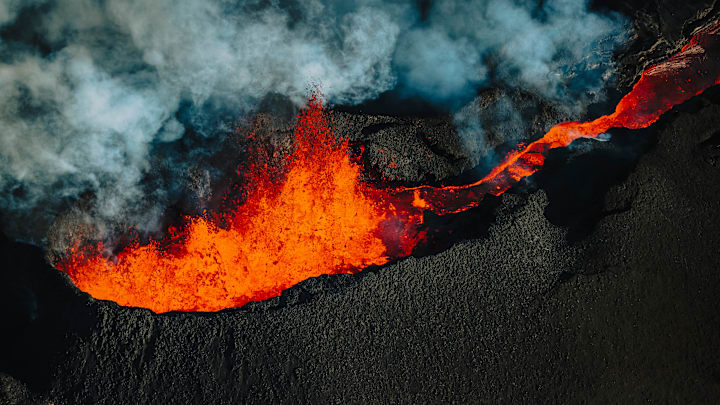In his movie 2012, Roland Emmerich’s 2009 love letter to the Mayan apocalypse, our heroes barely manage to escape Yellowstone National Park before it explodes beneath them. This not-so-subtle sci-fi sequence is actually based on something real: the Yellowstone supervolcano. What distinguishes this kind of volcano from regular volcanoes, and what will happen if—or when—it erupts?
Regular vs. Super Volcano

There are four main types of volcanoes: Cinder cones, composite or stratovolcanoes, shield volcanoes, and lava domes, which all rise above the earth. But supervolcanoes like the one under Yellowstone are calderas: vast sunken areas formed when the volcano expels all of its magma, and the land comes back to rest in the empty chamber. These calderas can be as big as 60 miles across (the current Yellowstone caldera, which sits on several older calderas, measures about 30 miles by 45 miles).
When Mount St. Helens, a stratovolcano located in Washington, erupted in 1980, the event rated a 5 on the Volcanic Explosivity Index (VEI) and expelled one cubic kilometer of ash. But supervolcanoes register 8 on the VEI and typically expel 10,000 times that volume of magma and ash. The most recent Yellowstone eruption, which occurred 630,000 years ago, released 240 cubic miles of volcanic debris.
The Yellowstone supervolcano is just one of several scattered around the globe. An incomplete list includes Taupo in New Zealand, which last erupted in the 3rd century CE. Before that was a supereruption of Toba in Sumatra, Indonesia, which occurred 74,000 years ago. There‘s a supervolcano near Pompeii, and one in Chile, too. There may be more we haven‘t yet discovered.
What Happens If A Supervolcano Erupts?

Below Yellowstone‘s surface—in some places as little as 5 or 6 miles deep—is a reservoir of solid rock and magma. Below that is a 45-mile-wide plume of molten rock that comes from at least 410 miles beneath the Earth‘s surface. This is what fuels Yellowstone‘s incredible geysers and geothermal pools. Bob Smith, who first described Yellowstone as “a living, breathing caldera” in 1979, says in his book Windows into the Earth that if the caldera were to erupt, “devastation would be complete and incomprehensible.”
First there would be swarms of earthquakes, then a huge blast that would wipe Yellowstone off the map. Clouds of ash and gas would burn everything in their paths. Ash would cover most of North America, destroying food sources. Some speculate that a supereruption from the Yellowstone caldera would instantly kill 87,000 people. Others say that such an eruption would lower the temperature of the Earth by at least 21 degrees, and might even block out the sun.
One study determined that if or when Yellowstone next erupts, it will probably be centered in one of three parallel fault zones running north-northwest across the national park.
Still, there‘s probably no reason to worry. Chances are that a supereruption won‘t occur in our lifetimes. Number crunchers have determined that only 1.4 supereruptions occur every million years, and, according to the U.S. Geological Survey, the odds of Yellowstone erupting are slim: just one in 730,000, or 0.00014 percent, a year.
A version of this story ran in 2012; it has been updated for 2023.
